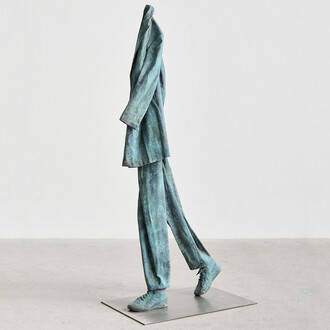Honor Fraser Gallery is pleased to present Jeremy Blake: Station to Station. On view in conjunction with exhibitions of recent work by Mel Davis and paintings from the 1960s and 1970s by Miriam Schapiro, a reception will be held at the gallery on November 4, 2017 from 4-7pm.
Station to Station is a five channel video—a time-based painting, as the late artist Jeremy Blake referred to his moving image work—in which the first, third, and fifth videos represent stations in an imagined urban transportation system while the second and fourth suggest travel between the stations. The flatscreen monitors on which the videos are displayed function as windows through which they can be viewed as landscapes that are framed, flattened, and constantly shifting. The non-narrative cinematic experience of Station to Station transforms the way space and time are perceived. Perpetual motion and steady pacing evoke the feeling of riding on a metropolitan subway system. Rectilinear, gauzy blocks fade in and out, often accompanied by the sound of a droning hum. In the station videos, architectonic forms appear and disappear, disrupting the illusion of a unified landscape, and the pulsating lights and mirage-like cityscapes of the travel videos offer abstractions of movement.
Installed side by side, the five videos present multiple perspectives on urban environments that are tainted by contemporary anxieties about nuclear weaponry, global warming, and surveillance technologies. Station to Station opens with Robert Moses Terminal. Responsible for many defining characteristics of New York City’s infrastructure, Moses’s impact on the way people move through that city inspired Blake’s thinking: “The fact that one person, and therefore one person's subjectivity, is the source for so much of what I had always assumed was the result of a gradual accumulation of projects by different planners struck me as disturbing.” Followed by Fordham Gneiss, Carbon Sink Park, Slumber Line, and Indiglo Heights, Robert Moses Terminal sets the stage for an exploration of rapidly changing urban landscapes and the carelessness with which these changes are executed.
Jeremy Blake was born in Fort Sill, OK in 1971. He died in New York, NY in 2007. Blake received a Bachelor of Fine Arts from the School of the Art Institute of Chicago in 1993 and a Master of Fine Arts from the California Institute of the Arts in 1995. One-person exhibitions of his work have been mounted at the Cleveland Institute of Art, Cleveland, OH (2005); San Francisco Museum of Modern Art, San Francisco, CA (2005); American Museum of the Moving Image, Astoria, NY (2003); Museum of Contemporary Art San Diego, San Diego, CA (2002); Blaffer Gallery, University of Houston, Houston, TX (2002); Contemporary Arts Center, Cincinnati, OH (2000); Pennsylvania Academy of the Fine Arts, Philadelphia, PA (2000); and the Shchusev Museum of Architecture, Moscow, Russia (2000). His work has been included in thematic exhibitions such as West Coast Visions, Borusan Contemporary, Istanbul, Turkey (2014); Opening Abstraction, Philbrook Museum of Art, Tulsa, OK (2013); Project Los Altos, San Francisco Museum of Modern Art, San Francisco, CA (2013); In the Séance Room: Acquisition Highlights from 2003-2013, Museum of Contemporary Art San Diego, San Diego, CA (2013); Go West! Representations of the American Frontier, The Blanton Museum of Art at The University of Texas, Austin, TX (2012); Blink! Light, Sound & the Moving Image, Denver Art Museum, Denver, CO (2011); Videosphere: A New Generation, Albright-Knox Gallery, Buffalo, NY (2011); The Artist’s Museum, Museum of Contemporary Art, Los Angeles, CA (2010); The Old Weird America: Folk Themes in Contemporary Art, Contemporary Arts Museum Houston, Houston, TX (2008); Signals: A Video Showcase, Orange County Museum of Art, Newport Beach, CA (2008); Pervasive Animation Programme One, Tate Modern, London, UK (2007); All the Pretty Corpses, Renaissance Society, University of Chicago, Chicago, IL (2005); Blur of the Otherworldly: Contemporary Art, Technology and the Paranormal, Center for Art and Visual Culture, University of Maryland, Baltimore, MD (2005); Whitney Biennial, Whitney Museum of American Art, New York, NY (2004, 2002, 2000); Art & Film in the Age of Anxiety, Santa Monica Museum, Santa Monica, CA (2002); 010101: Art in Technological Times, San Francisco Museum of Modern Art, San Francisco, CA (2001); BitStreams, Whitney Museum of American Art, New York, NY (2001); New Settlements, Louisiana Museum of Modern Art, Humlebæk, Denmark (2001); Elysian Fields, Centre Pompidou, Pairs, France (2000); Greater New York, MoMA PS.1, New York, NY (2000); One Dot Zero, Institute for Contemporary Art, London, UK (1999); and Aftershocks, Museum of Contemporary Art, Los Angeles, CA (1994).
















